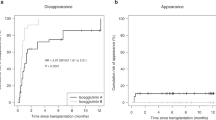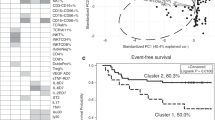Summary:
The aim of this study was to study the usefulness of erythrocyte antigen (EA) measurement to study engraftment after allogeneic HSCT. In all, 31 consecutive patients receiving HLA-identical bone marrow (BM) (n=13) or peripheral blood stem cells (n=18) were investigated. Apart from the ABO group, 15 EAs representing six minor blood groups were followed by the simple tube agglutination technique. A total of 20 (64.5%) patients received ABO-identical, eight (25.8%) received ABO minor and three (9.7%) received ABO major mismatched grafts. In all, 29 patients were followed for a median of 12 (6–16) months; 65% of the patients expressed donor type EA 1 month and almost all did so 6 months after transplant. Reticulocyte engraftment was significantly shorter than EA engraftment (median 18 vs 35 days) (P=0.001). Patients who received PB stem cells showed significantly faster EA and reticulocyte engraftment than patients who received BM stem cells (P=0.038 and 0.025). ABO compatibility did not have an impact on reticulocyte and EA engraftment (P=0.4 and 0.55). The earliest donor type EA detected was from the Rh and Kidd system. These data suggest that EA and reticulocyte assays are useful in monitoring engraftment.
This is a preview of subscription content, access via your institution
Access options
Subscribe to this journal
Receive 12 print issues and online access
$259.00 per year
only $21.58 per issue
Buy this article
- Purchase on Springer Link
- Instant access to full article PDF
Prices may be subject to local taxes which are calculated during checkout


Similar content being viewed by others
References
Van Dijk BA, Drenthe-Schonk AM, Bloo A et al. Erythrocyte repopulation after allogeneic bone marrow transplantation. Analysis using erythrocyte antigens. Transplantation 1987; 44: 650–654.
Petz LD, Yam P, Wallace RB et al. Mixed hematopoietic chimerism following bone marrow transplantation for hematologic malignancies. Blood 1987; 70: 1331–1337.
De Man AJ, Foolen WJ, Van Dijk BA et al. A fluorescent microsphere method for the investigation of erythrocyte chimerism after allogeneic bone marrow transplantation using antigenic differences. Vox Sang 1988; 55: 37–41.
Zago Novaretti MC, Dulley FL, Dorlhiac-Lacer PE et al. Use of the gel test to detect mixed red blood cell population in bone marrow transplantation patients. Vox Sang 1993; 65: 161–162.
Blanchard D, Bruneau V, Bernard D et al. Flow cytometry analysis of dual red blood cell populations after bone marrow transplantation. Br J Haematol 1995; 89: 741–747.
Gürman G, Arat M, Ilhan O et al. Allogeneic hematopoietic cell transplantation without myeloablative conditioning for patients with advanced hematologic malignancies. Cytother 2001; 3: 253–260.
Rowley SD . Hematopoietic stem cell transplantation between red cell incompatible donor–recipient pairs. Bone Marrow Transplant 2001; 28: 315–321.
Blazar BR, Orr HT, Arthur DC et al. Restriction fragments length polymorphisms as markers of engraftment in allogeneic marrow transplantation. Blood 1985; 66: 1436–1444.
Yam PY, Petz LD, Knowlton RG et al. Use of DNA restriction fragment length polymorphisms to document marrow engraftment and mixed hematopoietic chimerism following bone marrow transplantation. Transplantation 1987; 43: 399–407.
Leclair B, Fregeau CJ, Aye MT et al. DNA typing for bone marrow engraftment follow-up after allogeneic transplant: a comparative study of current technologies. Bone Marrow Transplant 1995; 16: 43–55.
Brunet S, Casals T, Madoz P et al. DNA polymorphisms as implant markers in allogeneic bone marrow transplantation. Preliminary evaluation. Med Clin (Barc) 1989; 93: 765–771.
Minden MD, Messner HA, Belch A . Origin of leukemic relapse after bone marrow transplantation detected by restriction fragment length polymorphism. J Clin Invest 1985; 75: 91–93.
Knowlton RG, Brown VA, Braman JC et al. Use of highly polymorphic DNA probes for genotypic analysis following bone marrow transplantation. Blood 1986; 68: 378–385.
Schouten HC, Sizoo W, Hagenbeek A et al. Incomplete chimerism in erythroid, myeloid and B lymphocyte lineage after T cell-depleted allogeneic bone marrow transplantation. Bone Marrow Transplant 1988; 3: 407–412.
Schaap N, Schattenberg A, Bar B et al. Red blood cell phenotyping is a sensitive technique for monitoring chronic myeloid leukemia patients after T-cell-depleted bone marrow transplantation and after donor leukocyte infusion. Br J Haematol 2000; 108: 116–125.
Wagner F, Wolpl A, Greher J et al. Method dependency of blood group determination after bone marrow transplantation. Beitr Infusionsther Transfusionsmed 1994; 32: 171–174.
Bar BM, Schattenberg A, Van Dijk BA et al. Host and donor erythrocyte repopulation patterns after allogeneic bone marrow transplantation analyzed with antibody-coated fluorescent microspheres. Br J Haematol 1989; 72: 239–245.
David B, Bernard D, Navenot JM et al. Flow cytometric monitoring of red blood cell chimerism after bone marrow transplantation. Transfus Med 1999; 9: 209–217.
Nelson M . An overview of the use of flow cytometry in the analysis of mixed red cell populations. Pathology 1999; 31: 191–198.
Greinix HT, Linkesch W, Keil F et al. Early detection of hematopoietic engraftment after bone marrow and peripheral blood stem cell transplantation by highly fluorescent reticulocyte counts. Bone Marrow Transplant 1994; 14: 307–313.
Bar BM, Schattenberg A, De Man AJ et al. Influence of the conditioning regimen on erythrocyte chimerism, graft-versus-host disease and relapse after allogeneic transplantation with lymphocyte depleted marrow. Bone Marrow Transplant 1992; 10: 45–52.
Author information
Authors and Affiliations
Corresponding author
Rights and permissions
About this article
Cite this article
Yıldırım, I., Özer, Y., Yüksel, M. et al. Erythrocyte antigen and reticulocyte engraftment after allogeneic hematopoietic stem cell transplantation. Bone Marrow Transplant 34, 351–355 (2004). https://doi.org/10.1038/sj.bmt.1704576
Received:
Accepted:
Published:
Issue Date:
DOI: https://doi.org/10.1038/sj.bmt.1704576
Keywords
This article is cited by
-
Follow-up of the patients after bone marrow transplantation for red blood cell chimerism using flow cytometry
Comparative Clinical Pathology (2014)



